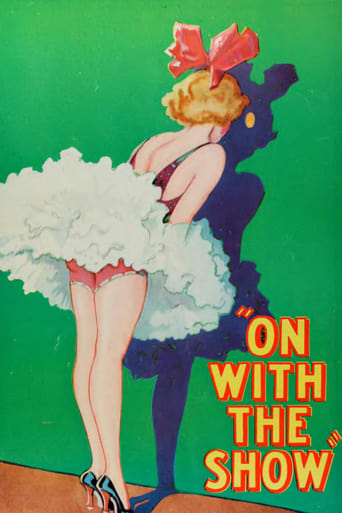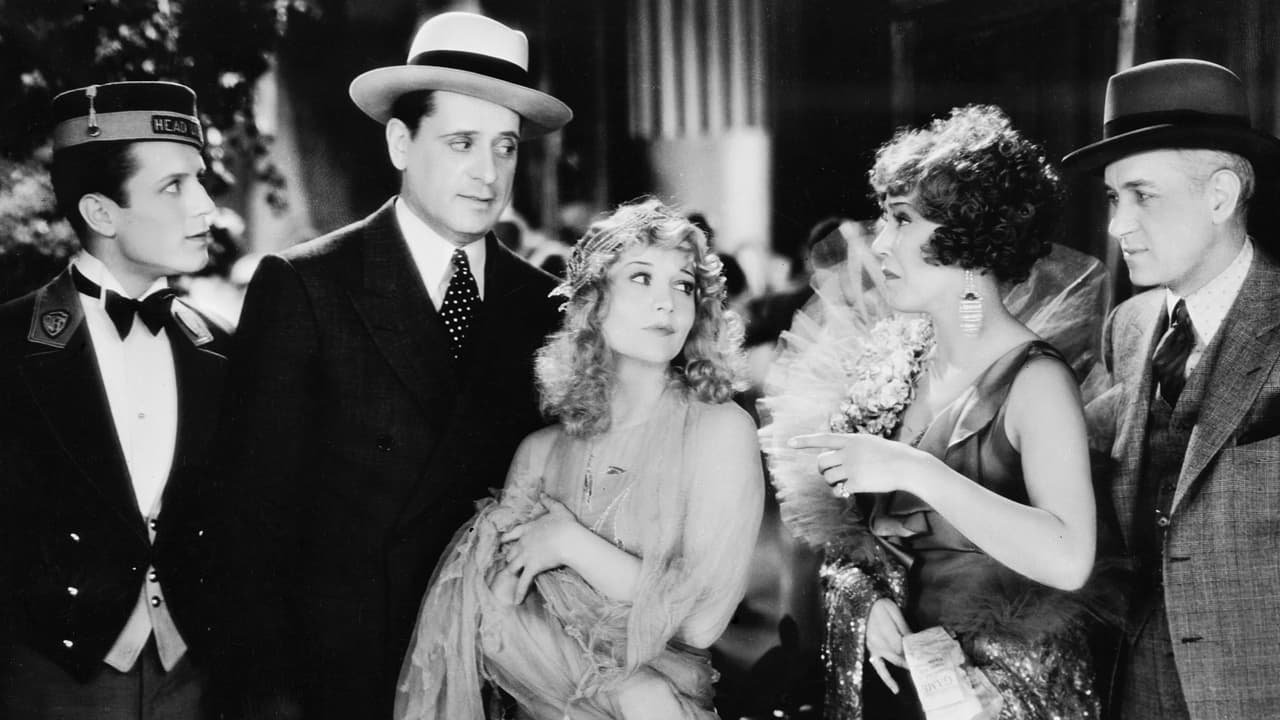mark.waltz
I'm glad that I've been given the gift of seeing old movies as a product of their time, otherwise I would not be able to get through "The Broadway Melody", "Hollywood Revue", "The Show of Shows", "Rio Rita" or the several dozen other ancient early movie musicals, all released in 1929. This smash hit is the extreme example of why they were so popular in the days before and after the market crash, as they were thoroughly modern and filled with the biggest song hits of the day. Like many others, this is a backstage story, telling the believable tale of what goes on in a Pre-Broadway tryout. The show backstage is more dramatic than the goings on in front of the audience. The leading diva (Betty Compson) has demands that can't be met, and the producer bemoans the lack of funds. As the show goes on, a dramatic robbery occurs, making the situation all the more dire.Best known for two memorable numbers featuring the legendary Ethel Waters (including her big hit "Am I Blue?"), this also has the rubber legged Joe E. Brown provides the laughs in front of the stage, but he's a pill to deal with backstage. Louise Fazenda, in a fright wig, gets the wisecracks, and the future Dagwood Bumpstead (Arthur Lake) gets falsely accused of the robbery. The dramatic scenes are short and sweet, often interjected during the musical numbers. The show itself seems to be a homage to the recent Broadway smash "Show Boat". Only infrequently static, this is practically perfect in every way. I would have loved some dramatic moments with Waters, truly moving in her brief time on screen. I have the feeling that her scenes could easily be cut for showings in the South, but for me, her involvement in this is as important as the principals. After all, her real life was all about going on with the show, keeping those tears hidden.
kidboots
Sally O'Neil couldn't sing or dance but that didn't stop Warner's giving her a leading role in this Technicolored song and dance fest. It was the very first all talking, all singing, all dancing, all Technicolored movie produced at Warners, who had dazzled audiences with "The Jazz Singer" in 1927. All color movies were never going to work in those early sound days, apart from the fact that colours didn't photograph true (blues tended to turn green and people's faces photographed pink), Technicolor needed lighting ten times as bright as black and white photography, so the heat in the studio was always intense. "On With the Show" was going to be the first of many Warner's films filmed in colour but aside from the problems mentioned, by the end of 1930 musicals were on their way out so only a few films were made. Now only Technicolor fragments remain - the finale from "Gold Diggers of Broadway" and "Wild Rose" from "Sally" etc. For years "On With the Show" was famous for being the film that "42nd Street" (1933) took it's plot from but it is clear that the only thing they have in common is the "eager newcomer saves show" cliché. Still in May of 1929 audiences would have been dazzled not only by the singing and dancing but by the glorious colour as well. The plot revolves around the off stage dramas and the musical numbers of "The Phantom Sweetheart", a play beset by financial worries and stuck in a one horse town - tonight it is Broadway or bust!!!Kitty (Sally O'Neil) a ticket seller, believes she could be "Broadway Bound" if only she was given a chance to prove herself. Jimmy (William Bakewell) the Head Usher and her sweetheart agrees. Meanwhile the cast are more concerned about their unpaid wages than "putting on a show" - most vocal is Harold (Arthur Lake) the whiney voiced juvenile, whose offstage bickering with his partner Joe (Joe E. Brown) is a running gag throughout the movie.The musical show starts out with a rousing ensemble number "Welcome Home" -highlight is a group of spirited tap dancers. Next temperamental star Nita French (Betty Compson) "in the flesh, baby, in the flesh" sings "Let Me Have My Dreams" - it is sang constantly throughout the film. Ethel Waters is then announced by Sarah (Louise Fazenda is a standout with her wicked laugh) and Ethel's performance is timeless. She sings the magnificent "Am I Blue" and later on the wonderfully saucy "Birmingham Bertha" ("I'm a real Simple Simon, wouldn't you know - I gave him a diamond and all of my dough"!!!). The wonderful John W. Bubbles from Buck and Bubbles is the cheeky dancer. He originated the role of Sportin' Life in the 1935 production of "Porgy and Bess" and even gave tap lessons to Fred Astaire. But those two timeless classics are interspersed with some not-so-great ones - like "Lift Your Juleps to Your Two Lips", another hearty ensemble piece in which Harold as the "leading juvenile" doesn't sing or dance but stands around posturing while Joe E. Brown, who is not very funny in this film, does an eccentric dance. Jimmy suggest that maybe he can rob the box-office, that way the cast will get their wages - later on there is a real robbery and of course Jimmy is the chief suspect. The big production number is "In The Land of Let's Pretend" - it would have looked spectacular in Technicolor. It's an extremely "talkie" film and seems quite long. It is densely plotted and there are so many speeches in the last third of the film - everything has to be explained - obviously they didn't think the audience could figure it out for themselves.When the studios found out Betty Compson was an accomplished musician her career was given a new lease of life in these singy, dancey days. Arthur Lake had the most irritating voice in films - it's hard to believe that he lasted long enough to be given his dream role of "Dagwood" at the end of the thirties. The Fairbanks Twins also provide some humour as a pair of high stepping chorus girls.Highly Recommended for Ethel Waters.
Ron Oliver
Desperate for Broadway, the traveling troupe of The Phantom Sweetheart must always go ON WITH THE SHOW!Here is another very early talkie musical, full of excitement for the new medium, but bloated by too much talk, unexciting songs sung by the chorus with mostly unintelligible lyrics and an overlong running time. The plot deals with the usual frustrations & jealousies that most backstage musicals seem to find requisite.The cast includes William Bakewell as the head usher eager to get his sweetheart, box-office girl Sally O'Neill, her chance at the Great White Way. Betty Compson plays the temperamental star and Arthur Lake the whiny young male lead. Louise Fazenda is the company's eccentric comedienne, who is given little to do but laugh at inappropriate moments.The film does have some compensations. Rubber faced Joe E. Brown is cast as the company's brash comic and, as always, he is funny simply to look at. Best of all, the incomparable Ethel Waters is brought in to sing a couple of songs, including 'Am I Blue?' Miss Waters has no connection with the rest of the story whatsoever, but just enjoying her for a few minutes is pure pleasure.
Cinebug
OK, so it's the old story about what goes on backstage in the production of a Broadway musical----even to the cliché of the star getting sick and the understudy taking her place and becoming a big star. Many critics see this as the inspiration for 42nd STREET, but this film has the period charm that only the transitional talkie musicals could have. Part of it is quite stagebound-----including musical numbers as you probably would have seen them on the Broadway stage in the 1920's, so if you don't care for very early musicals, you'd better pass on this one.
This was the film that introduced the song "Am I Blue" sung by a very young Ethel Waters, and followed by the even better "Birmingham Bertha" with black dancer John Bubbles. You should be warned that there are black dancers in the cast who wear some outrageous politically incorrect costumes---including one number where their costumes have watermelon stripes on them! And seeing Joe E. Brown as a mean comedian who constantly argues with Arthur Lake (better known as Dagwood Bumstead in the BLONDIE Series) will be something of a revelation to his fans. The film was made in the early two-strip Technicolor process, which unfortunately has yet to be found, but is still quite enjoyable in B & W. Remember, although this is a very charming transitional talkie musical, modern audiences will only see it as a horribly dated antique.


 AD
AD


